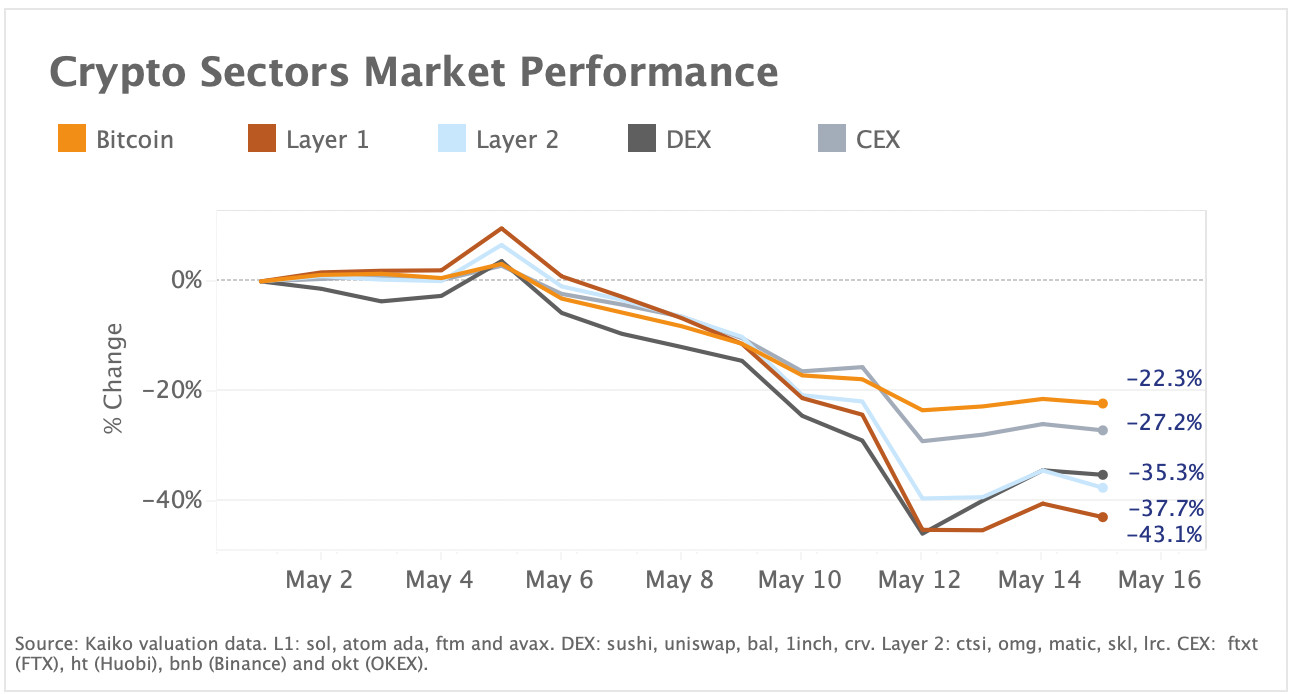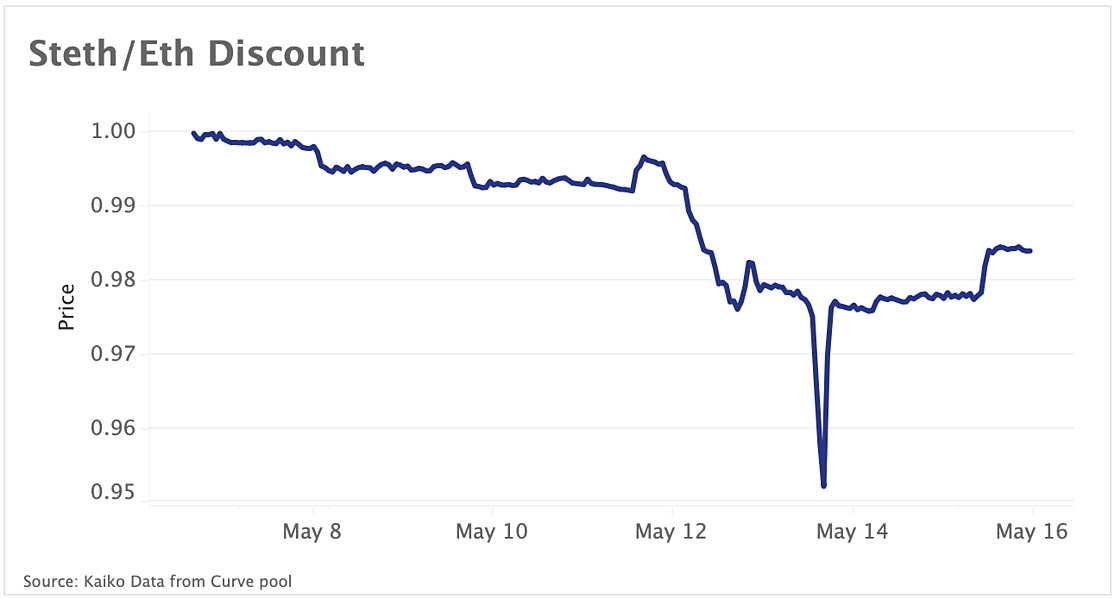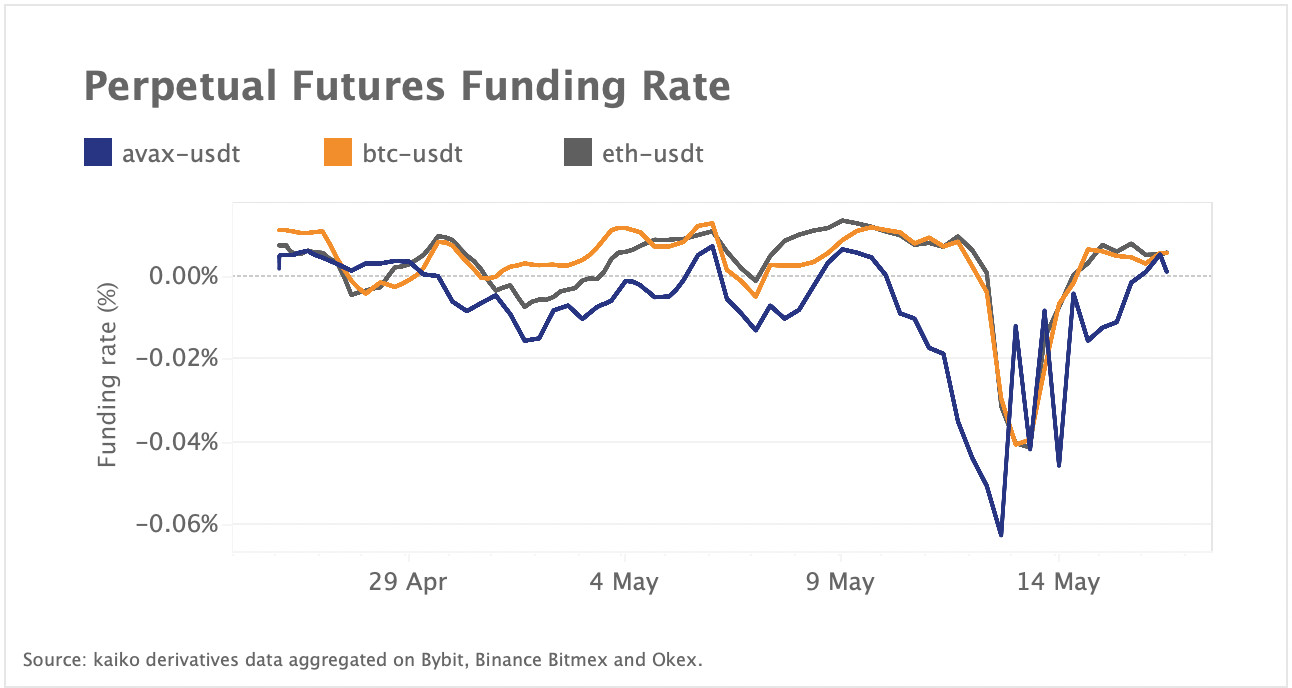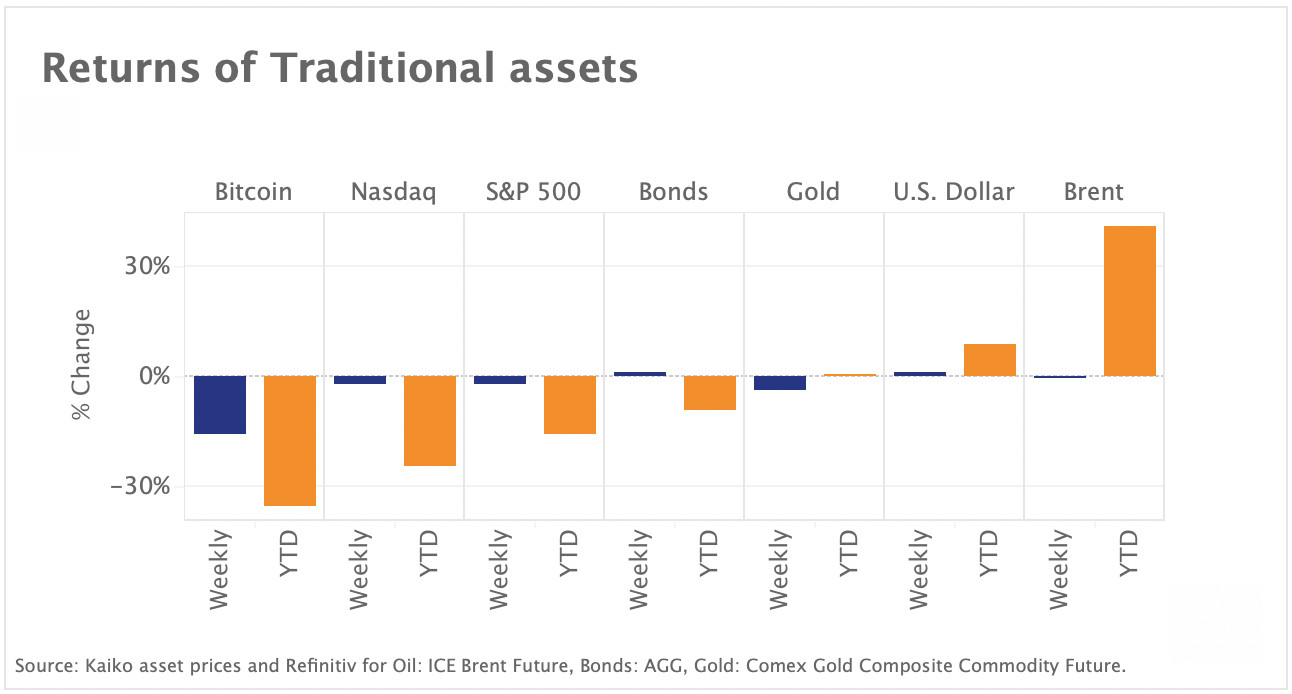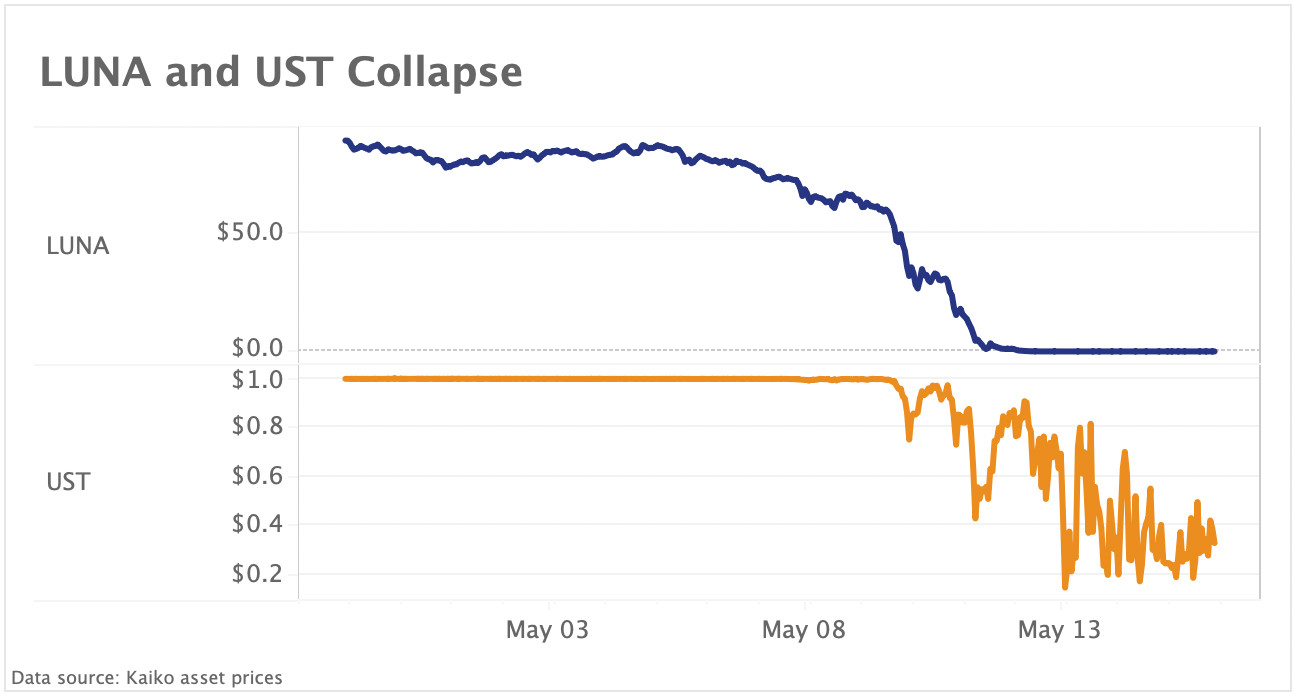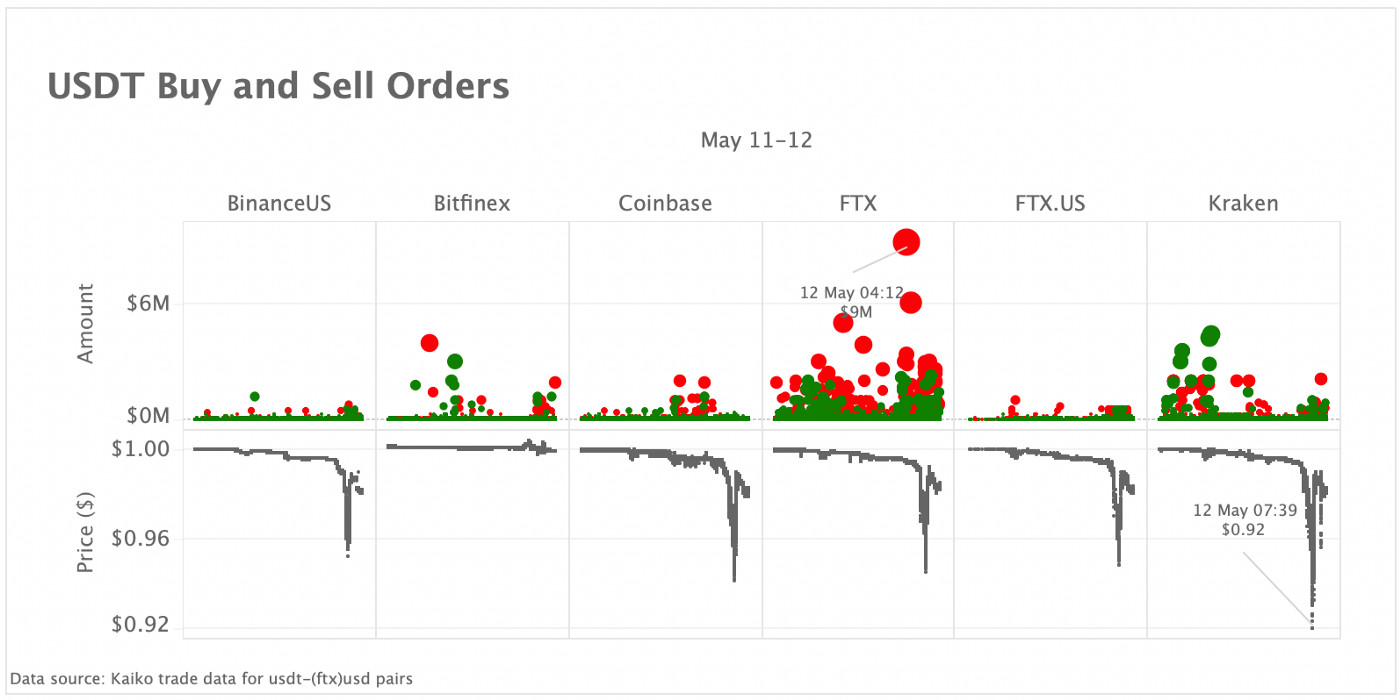A summarizing review of what has been happening at the crypto markets of the past week. A look at trending sectors, liquidity, volatility, spreads and more. The weekly report in cooperation with market data provider Kaiko.
The last 7 days in cryptocurrency markets:
- Price Movements: Bitcoin is again trading under $30k following a brief weekend respite.
- Order Book Liquidity: Stablecoin pair volume spiked to all time highs as traders shifted funds into "safer" stablecoins.
- Derivatives: Funding rates for AVAX, BTC, and ETH plummeted amid broad bearish sentiment and fears around Luna Foundation liquidations.
- Macro Trends: Coinbase's share price dipped to record lows following a drop in revenues.
Brief weekend respite goes south
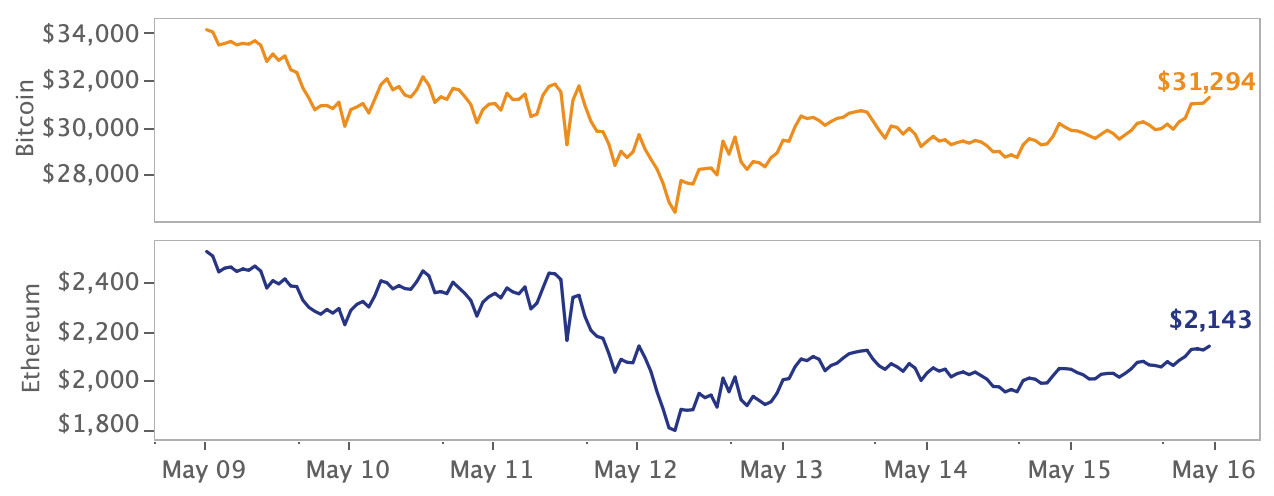
It's been a very tough week for financial markets, to say the least. As of Monday morning, Bitcoin (BTC) is again trading under $30k following a brief weekend recovery, and Ethereum (ETH) is trading just above $2k. The after effects of UST's collapse could be felt for a long time and will likely expand regulatory oversight of the stablecoin space. As expected during times of market volatility, both BTC and ETH outperformed most other market sectors, although all assets are down double digits.
Layer 1 blockchains were hit particularly hard by the loss of confidence following the Terra ecosystem’s collapse and are the worst performing crypto sector so far in May. Avalanche’s AVAX and Fantom’s FTM decline of over 40% this month is mirrored by a similar drop in the platforms’ total value locked, signalling significant capital outflows. Both decentralized (DEX) and centralized exchange (CEX) tokens have suffered amid a longer term drop-off in trade volumes, despite a brief surge during last week's sell-off.
stETH discount on Curve presents liquidation risk
Liquid staking protocol Lido warned last week that the swap rate for Staked Ether (stETH) and ETH was trading at a significant discount of 4-5% on the main Curve pool. StETH is Lido’s liquid solution to Ethereum staking ahead of the merge, allowing users to earn rewards for staking ETH while still being able to use a liquid token across various DeFi protocols. A large amount of stETH holders use the token to stack yield on DeFi protocols, known as leveraged staking, and a discount of a few % in the stETH/ETH ratio can lead to their positions being liquidated.
Lido reiterated that stETH will still be redeemable 1:1 for ETH post-merge, leaving long-term holders unaffected, but stated that this deviation will affect those with leveraged positions and urged leveraged stakers to immediately de-risk. Later in the week Lido announced an additional liquidity pool on Curve, distributing extra rewards to LDO token holders in order to help improve liquidity around the stETH/ETH peg. Their efforts seem to have helped reduce the discount, with stETH trading at a 1.5% discount to ETH this morning.
Stablecoin pair volume surges to all time highs
In normal market conditions, stablecoin trading pairs have relatively low volumes due to a lack of volatility and arbitrage opportunities. That all changed last week as both UST and USDT depegged, causing stablecoin volumes on centralized exchanges to surge to an all-time high of $27B. Above, we chart the aggregated trade volume for the most traded pairs which contain a stablecoin as the base asset.
UST accounted for nearly 40% of all stablecoin volume over the past week, up from just 9% prior to the selloff. With the bulk of UST supply concentrated on Terra’s Anchor protocol, the strong selling pressure resulted in a liquidity crunch, forcing some exchanges such as Binance and Kraken to suspend UST and LUNA withdrawals. As the selloff spilled into other stablecoins on May 12, both USDC and USDT trade volumes spiked to all-time highs of $9B and $6.8B respectively. Many traders converted USDT to USDC during the depegging, while others traded USDT pairs to profit off of the 1:1 redemption mechanism still offered by Tether Limited. The Luna Foundation Guard has also revealed that they liquidated millions in USDT and USDC reserves to defend UST's peg, likely contributing to the increase.
Funding rates dip negative as markets tank
Negative market sentiment hit perpetual futures markets as funding rates across most assets went negative last week. AVAX funding rates in particular dipped sharply after the LUNA collapse as fears circulated that the Luna Foundation Guard (LFG) would sell nearly 2 million AVAX tokens (over $60mn USD) it held to defend the UST peg. However, LFG confirmed this morning that it still holds its AVAX position. L1s have suffered across the board and will likely continue to face heightened scrutiny as a result of Terra’s failure. Funding rates, which are broadly seen as a sentiment indicator (bearish when negative and bullish when positive) re-set over the weekend as risk sentiment stabilised.
Risk-off mood deepens following U.S. inflation print
The risk-off mood, which has dominated market sentiment since the start of the year, deepened last week with nearly all asset classes registering considerable outflows. A higher-than-expected inflation print for April and falling consumer sentiment is raising concerns that more aggressive monetary tightening could be on the horizon. Bitcoin is the worst performer over the past week and YTD, although Nasdaq and the S&P 500 aren’t faring much better. As expected, safe-haven demand remains strong, with the U.S. Dollar hitting another fresh 20-year high. Bitcoin’s correlation with the Dollar Index has been mostly negative over the past year, oscillating between -0.2 (uncorrelated) to -0.6 (inversely correlated), which suggests a rising dollar bodes poorly for BTC.
Coinbase and Galaxy Digital stocks plummet
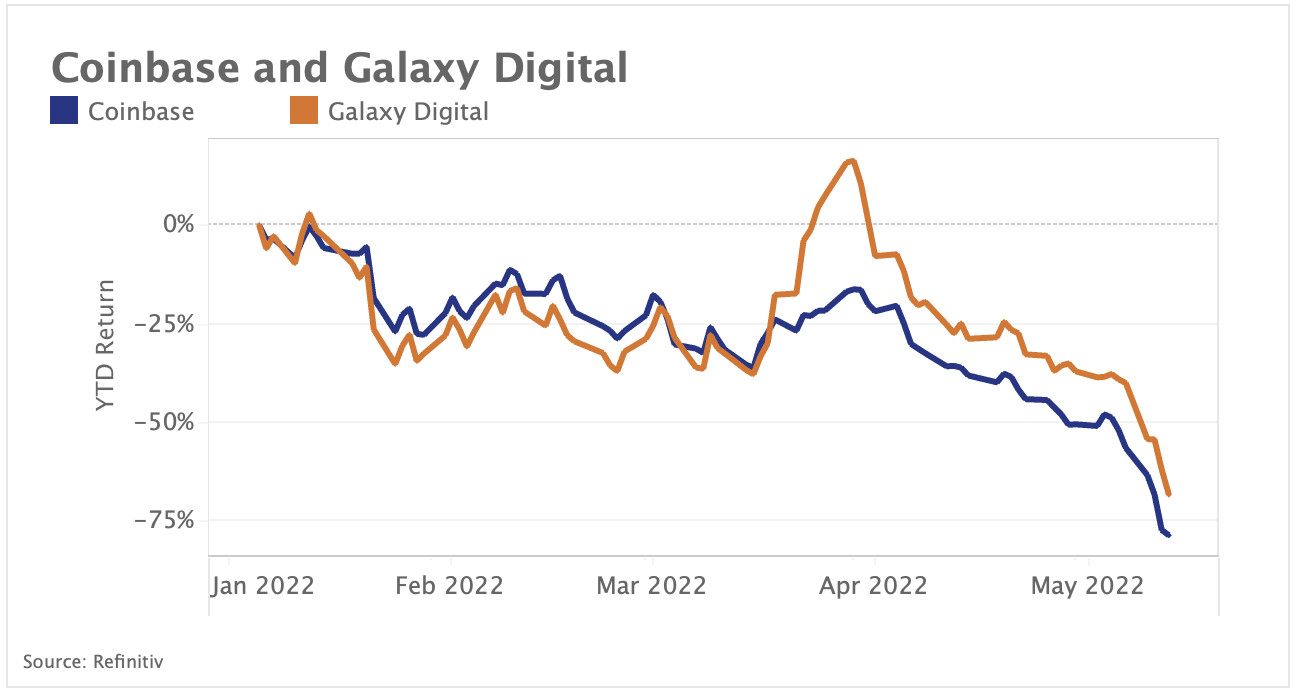
Share prices for Coinbase and Galaxy Digital have declined sharply since April as crypto markets experience a variety of headwinds. Trade volumes have slumped considerably, cutting into Coinbase’s revenues, while Galaxy Digital has lost $300mn QTD due to poor returns for their crypto investments (Galaxy was a strong backer of Luna). Additionally, Coinbase faced intense scrutiny this week after it revealed that crypto it holds for customers could be subject to bankruptcy proceedings, leading many to urge users to remove their crypto from the exchange.
LUNA ETP share prices fall to zero
Luna’s historic meltdown has led to the implosion of Luna-indexed exchange traded products which lost nearly all of their value last week. 21Shares' Terra ETP - the world’s first Terra ETP, listed on the SIX Swiss Exchange in January, closed Thursday at $0.004, down over 99% since May 6. VanEck's Terra ETN (Exchange Traded Note), which trades on several European markets, faced a similar decline, closing the week at $0.005. Both investment vehicles halted issuance and redemption on Friday. Several high-profile investment and venture companies backed Terraform Labs over the past months, which added to speculations about the potential ramifications of Luna’s meltdown on both investors’ risk tolerance and regulation.
$40 billion in value vanished
Last week, cryptocurrency markets witnessed one of the largest financial collapses in history following the catastrophic depegging of TerraUSD, the algorithmic stablecoin native to the Terra blockchain. As of writing, LUNA - the cryptocurrency that backed UST and once had a market cap of $40 billion - is trading at effectively zero, having experienced hyperinflation into the trillions as UST holders desperately sought redemptions.
Over the weekend, the Terra community discussed a path forward, with founder Do Kwon endorsing a plan that would essentially involve resetting the blockchain to 1 billion LUNA tokens, rewarded to LUNA and UST holders (prior to the depegging) and a community fund. This plan would abandon UST in favor of preserving application development on Terra.
Tether reaches historic lows
Cryptocurrency markets are still shuddering in the aftermath of the historic collapse, which caused all sectors to plummet and Tether (USDT) - the largest and most systemically important stablecoin - to depeg to multi-year lows of $0.94. As of Monday morning, the stablecoin is still trading below $1, although a worst case scenario seems to have been avoided.
Market microstructure was particularly interesting to observe during the market mayhem. From one day to the next, FTX's market share of volume for USDT-USD pairs surged from 16% to more than 45%, and we observed a series of large sell orders during the depegging. Traders could theoretically just redeem U.S. Dollars at exactly 1:1 from Tether Limited, which claimed to still be processing redemptions normally, which poses questions as to why traders would sell USDT below $1.


